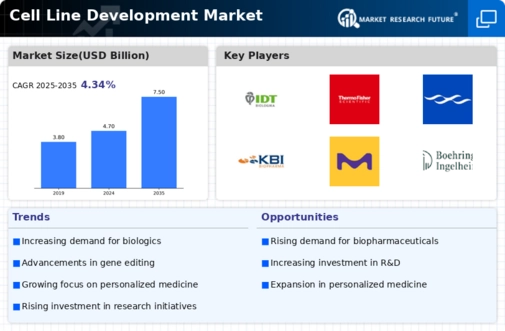Cell Line Development Market Summary
As per Market Research Future Analysis, the Cell Line Development Market was valued at 7.11 USD Billion in 2024 and is projected to grow to 25.03 USD Billion by 2035, with a CAGR of 12.12% from 2025 to 2035. The market is driven by the rising demand for biopharmaceuticals, technological advancements, and increased R&D expenditure. Key applications include Drug Discovery and Bioproduction, which are crucial for therapeutic development.
Key Market Trends & Highlights
The Cell Line Development Market is witnessing transformative trends driven by innovation and demand.
- Rising demand for biopharmaceuticals is propelling market growth, with 18 million new cancer cases projected to rise by 47% by 2030.
- Technological advancements, particularly in genome editing like CRISPR, are enhancing productivity and efficiency.
- Collaborative research initiatives between academia and biotech firms are accelerating development timelines, with 80% of biotech companies reporting benefits.
- Increased R&D expenditure reached approximately USD 1.7 trillion globally, significantly benefiting the cell line development sector.
Market Size & Forecast
| 2024 Market Size | USD 7.11 Billion |
| 2035 Market Size | USD 25.03 Billion |
| CAGR (2025-2035) | 12.12% |
Major Players
Key players include Sartorius AG, IDT Biologika, Thermo Fisher Scientific, Lonza Group, and Merck KGaA.




















